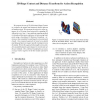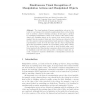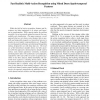24 search results - page 3 / 5 » A Hierarchical Model of Shape and Appearance for Human Actio... |
ICPR
2008
IEEE
14 years 6 months ago
2008
IEEE
We propose the use of 3D (2D+time) Shape Context to recognize the spatial and temporal details inherent in human actions. We represent an action in a video sequence by a 3D point ...
ECCV
2008
Springer
14 years 7 months ago
2008
Springer
Abstract. The visual analysis of human manipulation actions is of interest for e.g. human-robot interaction applications where a robot learns how to perform a task by watching a hu...
ECCV
2010
Springer
13 years 8 months ago
2010
Springer
Abstract. Much recent research in human activity recognition has focused on the problem of recognizing simple repetitive (walking, running, waving) and punctual actions (sitting up...
PVLDB
2008
13 years 4 months ago
2008
Trajectory classification, i.e., model construction for predicting the class labels of moving objects based on their trajectories and other features, has many important, real-worl...
ICCV
2009
IEEE
13 years 3 months ago
2009
IEEE
Within the field of action recognition, features and descriptors are often engineered to be sparse and invariant to transformation. While sparsity makes the problem tractable, it ...



